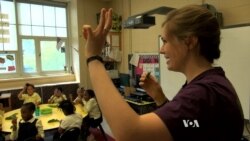The kindergarten students at John Burroughs Elementary School are staying an hour later on this day – not to brush up on their reading or math skills, but to taste kale – many for the first time.
“Yum, it tastes good,” said Robert Smith as he puts the green leaves seasoned with olive oil in his mouth.
Since the start of the school year, FoodCorps member Karen Davison has spent each day in a Washington, D.C., classroom introducing new vegetables to these five-year-olds, while teaching them where their food comes from and how they can make healthier choices on a daily basis.
“They see a lot of packaged food. If they eat vegetables, it’s not necessarily fresh. It’s not necessarily whole, so being able to bring in fresh vegetables, leafy greens, interesting fruit, is really a great experience for these students,” Davison said.
FoodCorps
In its fifth year, FoodCorps puts more than 180 young Americans into 500 schools across the United States. There, they focus on teaching students about nutrition, engaging them with hands-on activities, and improving their access to healthy foods whether in the cafeteria or the greater community.
FoodCorps, a grantee of the AmeriCorps service program, also partners with existing organizations to plant gardens in schools and bring healthier options to stores, particularly in urban areas where choices may be limited.
FoodCorps Fellow Maddie Morales says the mission is particularly critical at a time when U.S. obesity rates in children have doubled in the last 30 years.
“The repercussion of having an unhealthy population is absolutely unacceptable and really scary in some ways that it affects our national security. It affects our ability to be a productive country and it is imperative that we change the system,” Morales said.
First lady's mission
It’s a message echoed by first lady Michelle Obama, who chose FoodCorps cofounder Debra Eschmeyer in January to serve as senior nutrition policy adviser and head of the "Let’s Move" initiative, aimed at reducing childhood obesity within a generation through healthy eating and exercise.
“For more than a decade, Deb has been leading the way in teaching kids about the importance of healthy eating,” Obama said in a statement. “From classrooms and gardens to kitchens and farms, Deb has made learning about nutrition fun and accessible for kids across the country.”
Eschmeyer joined Obama at the annual White House Kitchen Garden planting in April, where she also marked the fifth anniversary of "Let’s Move."
On a sunny day in the South Lawn, the first lady knelt alongside students from around the country, planting spinach, radishes, bok choy, broccoli and lettuce, while urging people to plant their own gardens and share five things they are doing to lead healthier lives through her #GimmeFive challenge.
“Let’s share our progress because we are going to come back and harvest in a few months. And I would love to see what other community gardens, schools, school gardens are doing out there to move forward on getting our kids to eat healthy,” Obama said.
Let's move!
Obama began Let’s Move in February of 2010, citing rising obesity levels among American children and the associated risk of chronic illnesses including diabetes, heart disease and asthma. According to the Centers for Disease Control, more than one-third of children and adolescents are overweight or obese. The number is even higher among African-American and Hispanic youth.
The first lady has worked to put healthier foods in schools and encourage physical activity among young people, while partnering with major U.S. companies like Nike to ensure the effort is lasting.
Peter Slevin, author of Michelle Obama, A Life, says Let’s Move! is in line with the first lady’s mission to help the disadvantaged in the United States.
“In terms of her policy legacy, I think there is an element to addressing inequality in everything she does, including as a mentor and in her nutrition program,” Slevin said. “Keep in mind that there are roughly 30 million meals sold in public schools each day and about 70 percent of them are bought by kids who can’t afford to pay full freight. So nutrition is particularly important to these students.”
Back at John Burroughs Elementary School, just a few kilometers from the White House, young minds are already being changed due to efforts like FoodCorps. And it’s not just the students who are learning to eat healthier.
Kindergarten teacher Dionne Hammiel says FoodCorps member Davison has encouraged her to eat vegetables she never thought she would like.
“The kale especially, it was like, 'No thank you.' So she said, 'Try it this way.' I was like, ‘Oh, I like it.’ I went home and started making kale for myself,” Hammiel said.
Hammiel says the program has exposed her students to healthy eating habits they will hopefully keep with them for years to come.







